|
|
The Flytier:
Dennis Collier of Longmont, CO |
|
Dennis
fell in love with fly fishing as a young boy, while sitting on
a stream bank watching his father fly fish. His introduction
to fly tying also came at an early age, when Santa delivered
the well-remembered "Basic Fly Tying Kit" one Christmas.
That was over 40 years ago. Today, Dennis guides and
instructs in Colorado and enjoys sharing his many innovative
fly patterns. |
|
Be sure to see Dennis's other story:
SnoBalls in Summer |
When
Peter Frailey, owner of this Web site, sent me a sample of
his streamer called the
Woodchuck Special, I was immediately impressed with the
beauty of the fly and possibilities for further design
tinkering. After all, as a fly tier I’m also a firm
believer “if it ain’t broke, fix it”.
It was
also around this time that I was introduced to the new
Daiichi #1870 Swimming Larvae hook. I was enamored with the
graceful profile of this hook, but soon felt it had far
greater potential than merely being attached to a San Juan
Worm as suggested by it’s namesake.
My first
endeavor utilizing the #1870 was on an Angora goat leech
pattern, which has proven very successful on many
Colorado/Wyoming lakes. When tied with a small lead wire
counterweight at the hook bend, the #1870 rides point-up and
provides a very realistic “undulating” action during the
strip retrieve.
That was
the beginning and end of my “mad scientist” creations with
the #1870 until I made a commitment to join a group of
friends headed to southwestern Alberta in 2005. One object
of our pursuit will be the numerous cutthroat trout, which
inhabit the regional streams and rivers. As I pondered what
these cutthroat might like to chew on, Peter’s Woodchuck
Special (if you get a chance, read
Rob Knisely's excellent
story about this fly) came to mind as a potentially good
“attractor pattern” and I recalled that Peter had also sent
me a patch of New England woodchuck fur. With that, it was
back to the drawing board - or tying vise in this case. As
a result, in the photographs here, you'll see a couple of my
samples sporting woodchuck wings.
Having
dabbled in tying classic salmon flies in the past, it struck
me that the #1870 had a vague similarity to some salmon iron
designs I’d seen. Visually drawing a vertical line between
the hook point and end of the level hook shank, it became
evident the hook offered an interesting drop bend, short
shank and turned up eye - which I personally found quite
attractive. Since then, I’ve adapted the hook to such
patterns as the Needle Hopper, Stimulators, my signature
Wet-Wire series, the Matuka and others. And, that’s just
the beginning, as many pattern ideas are swimming around in
my head just waiting to be tied.
If
you’re a fan of the “dry-dropper” approach to fishing - in
which the dropper tippet is attached to the bend of the dry
fly - the unique design of this hook is custom-made for such
applications. The heavier wire of the #1870 also offers
additional strength for those occasions when you snag “Ol
Walter” on the dropper fly – a situation that can seriously
strain the bend on lighter wire hooks.
Many
times, we fly tying/fly fishing types become stuck in deep
ruts. Resorting to what’s been done before, time and time
again, pulling the same flies out of our boxes, trip after
trip. Sound familiar? I’d encourage you to think
outside the box and explore the creative possibilities this
wonderful hook design has to offer. Swimming larvae might
make good fish food but they can be tied on hooks with far
less intrinsic beauty. As for me, I see giant #1870
Pteronarcies Californica dry flies dancing across the
riffles of the Madison River, and big browns rising to the
occasion. 1870 is a very good year for fishhooks!
--Dennis
Collier
|
#1870 Woodchuck
Streamer |
|
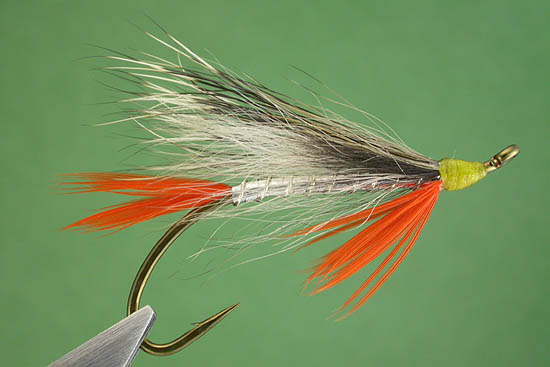
Photo by Peter Frailey
Hook: Daiichi 1870, size 8
Thread: Yellow Wapsi UTC 70
Tail: Orange schlapen
Body: Silver flat Mylar tinsel
Rib: Silver Wapsi UTC wire, fine
Beard: Orange schlapen
Overwing: Woodchuck underfur and
guardhair mixed |
|
|
#1870 Needle Hopper |
|
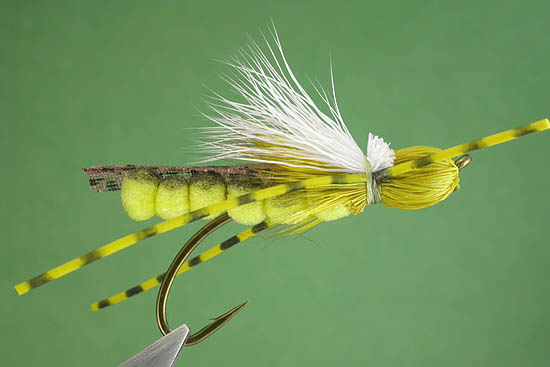
Photo by Peter Frailey
Hook:
Daiichi 1870, size 10
Thread: Yellow Danville 3/0 monocord
Extended Abdomen: Yellow 3mm open-cell
foam
Wing: Mottled brown Web Wing
Head: Dyed yellow deer hair tied bullet
style.
Legs: Yellow centipede legs
Indicator: Florescent white deer belly
hair.
Comments: The first three segments of the
abdomen are tied on a needle, removed and
attached to the hook just above the point.
|
|
|
#1870 Rubber-legged
Stimulator |
|
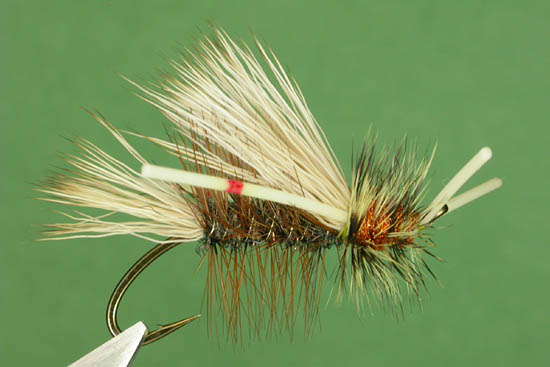
Photo by Peter Frailey
Hook:
Diiachi 1870, size 10
Thread: Dark brown Uni-thread 8/0
Tail: Blond elk hair
Hackle #1: Furnace brown, palmered over abdomen
Abdomen: Peacock Ice Dub
Rib: Gold Wapsi UTC wire (fine)
Wing: Blond elk hair
Legs: Cream round rubber
Thorax: Orange Ice Dub
Hackle #2: Grizzly dyed yellow, palmered over thorax |
|
|
#1870 Wet-Wire
Softhackle |
|
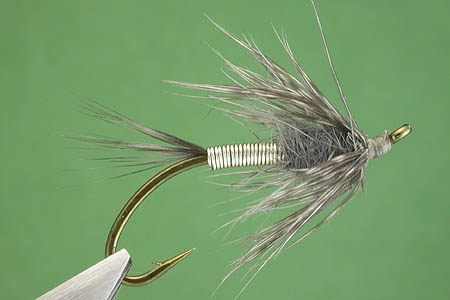
Photo by Peter Frailey
Hook: Daiichi 1870,
size 12
Thread: Dark brown Uni-thread
8/0
Tail: Hackle fibers
Abdomen: Wapsi UTC copper wire, size BR
Thorax: Grey rabbit
Collar: Natural Whiting Brahama soft
hackle
Comments:
This pattern lends itself to a
wide variety of color combinations applicable to
matching the naturals, or as an attractor |
|
|
#1870 Woodchuck Wet |
|
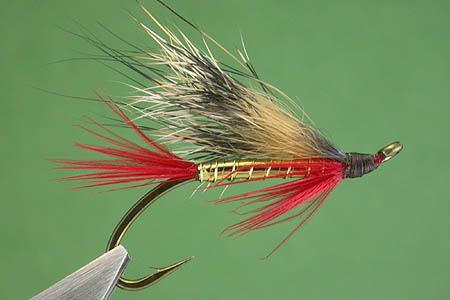
Photo by Peter Frailey
Hook:
Daiichi 1870, size 14
Thread: Dark
brown Uni-thread 8/0
Tail: Red schlapen
Body: Gold
flat Mylar tinsel
Rib: Gold Wapsi UTC wire, fine
Throat: Red schlapen
Wing: Woodchuck with underfur and
guardhairs mixed
Comments: Fox squirrel
body can be substituted for the wing on smaller
flies. |
|
|